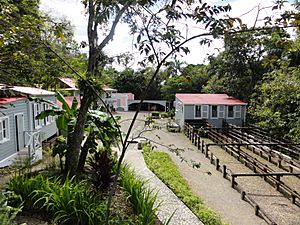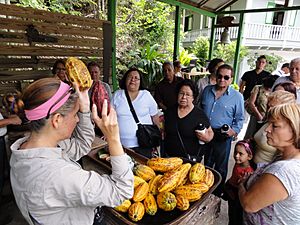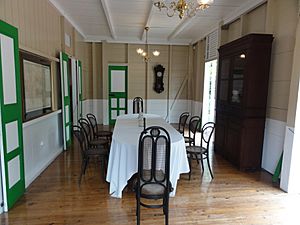Museo Hacienda Buena Vista facts for kids

Partial view of Museo Hacienda Buena Vista complex
|
|
| Lua error in Module:Location_map at line 420: attempt to index field 'wikibase' (a nil value). | |
| Established | 1987 |
|---|---|
| Location | Ponce, Puerto Rico |
| Type | Farm museum |
| Visitors | 40,000/year |
| Owner | Private: Fideicomiso de Conservación de Puerto Rico. |
Museo Hacienda Buena Vista is a cool historic coffee farm museum located in Barrio Magueyes, Ponce, Puerto Rico. It opened its doors in 1987 and welcomes about 40,000 visitors every year. People often call it "Puerto Rico's first living museum of art and science" because it brings history to life!
This amazing place was originally a coffee plantation owned by the Vives family in the 1800s. Today, the land and buildings belong to the Fideicomiso de Conservación (Puerto Rico Conservation Trust), which runs the museum. It sits on about 82 acres of rich land, including a humid subtropical forest. You can find it about 7 miles north of Ponce on Route PR-123.
At Museo Hacienda Buena Vista, you can see how a coffee plantation worked long ago. The old farm machines are running again, farm animals wander around, and the farmhouse rooms are filled with furniture from the past. You can even smell fresh coffee roasting! Visitors can take tours through the old Vives family home and explore all the plantation buildings. It's a great way to learn about 19th-century farming.
Contents
A Look Back: The Hacienda's Story
The plantation began in 1833, started by Don Salvador de Vives. The main house, called the "Manor House," was built in the Spanish Colonial style. Other buildings were made in the local criollo style. Don Salvador grew crops to sell in the Ponce market and to nearby sugarcane farms. At first, the Vives estate was huge, covering about 500 acres.
In 1845, Don Salvador's son added a corn mill to the farm, which was already making money from fruits and vegetables. Later, his grandson started growing and processing coffee. This happened during the big coffee boom of the 1880s and 1890s. Both Don Salvador's son and grandson brought in some of the most advanced farm machines on the island. These machines were powered by a waterfall about 100 feet tall! Hacienda Buena Vista became one of the most successful plantations in Puerto Rico's mountains.
Around 1900, strong hurricanes and a drop in coffee prices caused problems for the Hacienda. Operations slowed down, and the place slowly fell apart. By 1937, farming in Puerto Rico had declined a lot. The plantation business stopped, and the Hacienda became mostly a weekend home for the Vives family. Worker buildings, other structures, and equipment quickly wore out in the tropical weather.
In 1956, a new law in Puerto Rico aimed to give land to local farmers. Because of this, the government took over most of Hacienda Buena Vista's land. Only 87 acres remained with the Vives family, including the main house and the water canal system.
The Conservation Trust of Puerto Rico bought these remaining 87 acres in 1984. Their goal was to bring the Hacienda back to life. Even though the coffee-processing machines and farm buildings were in bad shape, the Trust managed to restore everything. They wanted to teach people about the "golden age" of coffee growing in Puerto Rico's mountains. The original owners even donated many old furnishings, and the Trust bought other authentic pieces.
By 1986, the restoration was finished, and the Hacienda became a museum. It opened in 1987 and has been open ever since. It's the only museum of its kind in Puerto Rico! In 1988, the Trust also rebuilt the coffee mill to look just like it did in 1892.
Why This Museum Is Special
The Museo Hacienda Buena Vista is important for several reasons. First, it has the only remaining example of a Barker hydraulic turbine. This was the very first type of reaction turbine ever made! In July 1994, the American Society of Mechanical Engineers recognized it as a Mechanical Engineering landmark.
Second, the museum shows us one of the best examples of an old Puerto Rican coffee plantation. This is a big deal because, in the late 1800s, coffee from Puerto Rico was considered some of the best in the world. It was even said to be a favorite at the Vatican! Hacienda Buena Vista also shows how the coffee industry changed over time. You can see different periods, from growing crops like plantains (1833–1845) to making flour from rice and corn (1847–1872). These foods were very important for the people living there.
Exploring the Museum
Museo Hacienda Buena Vista is both an open-air museum and an indoor museum. It's located in Barrio Magueyes, in the town of Ponce, Puerto Rico. The museum sits high up, between 525 and 1,500 feet above sea level. This means the air is cool at night and moist during the day. The hills around the Hacienda are perfect for growing corn, coffee, and fruits.
This open-air museum covers about 87 acres of farmland. Its main buildings are grouped together in a central area of about 3 acres. The property includes 11 original buildings: the Hacienda's main house, the carriage house, horse stables, mule stables, the caretaker's house and office, two warehouses, a hurricane shelter, the corn mill, and the former worker housing. There's also a working water canal system, an aqueduct, and a beautiful house garden. The building where coffee beans were processed was rebuilt to look like the original 1892 structure.
The Manor House and Other Buildings
The manor house is a two-story building, about 60 by 50 feet, built in 1845. It's the main indoor attraction at the museum and a central point for all other structures. The ground floor was used for storage. The second floor has three bedrooms and a living room. The eastern part of the manor house is made of brick and includes a courtyard, the kitchen, two more bedrooms, and a bathroom. The manor house also has a garden surrounded by a wrought iron and brick fence. This garden was once the formal entrance to the Hacienda and a private family space. The carriage house, stables, and a small caretaker's house are nearby. You can also visit the mule stables and the caretaker's office. Across from the manor house is the hurricane shelter. It's a strong brick building, about 15 feet by 25 feet, built 3 feet above the ground. Its walls, floor, and ceiling were made to survive the powerful tropical storms common in this area.
Water Canals and Aqueduct
A major highlight of the museum is the brick-and-mortar canal. It's 18 inches deep, 12 inches wide, and about 2,600 feet long! A water drop of 360 meters provides the power needed to run the mills at the Hacienda. The canal and aqueduct were finished in 1851. A system of gates helps direct the water for different farming needs. One gate sends water to the water wheel and the corn mill's water turbine. Another gate sends water to the fermentation tank, a decorative washbasin, and a bath. A third gate sends water back to the Canas River.
Coffee Processing Mills
The coffee de-pulping and husking mill is a two-story wooden building located northwest of the manor house. It first held the 1845 corn mill. But in 1892, it was changed to become the coffee husking mill.
Corn Mill and Bean Drying Area
A second corn mill at the Hacienda Buena Vista Museum was built in 1854. It's a two-story wooden building, about 16 feet wide and 25 feet long. The actual corn grinding happened on the floor of this mill. Dried corn would go through a hopper in this building to be processed into cornmeal. It was also packed into bags here. One of the aqueduct canals ran under this building to power the corn mill above. A bean drying station is also part of the exhibits; this building dates from 1847. This building had previously been used as housing for workers, but after the abolition of slavery in Puerto Rico in 1873, it was turned into a bean drying building. The large pans used for drying coffee beans were kept here too.
A Lasting Legacy
On July 16, 1994, Robert B. Gaither from the American Society of Mechanical Engineers gave a special award to the Puerto Rico Conservation Trust. This plaque named Hacienda Buena Vista's hydraulic turbine a National Historic Monument of Mechanical Engineering. The award recognized not only the turbine's importance but also the amazing work the Conservation Trust did to restore it. You can see a copy of this award in the museum's gift shop.
Gallery
See also






